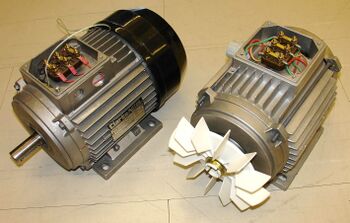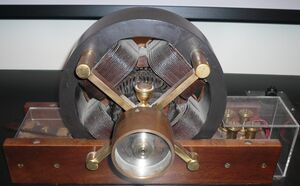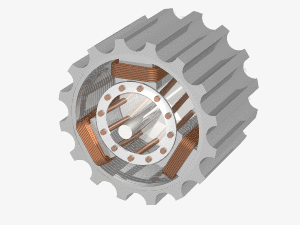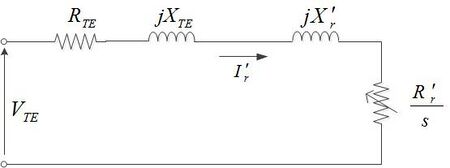محرك حثي


المحرك الحثي هو محرك تيار متردد يقوم بتحويل الطاقة الكهربائية إلى طاقة حركية وهو أحد تطبيقات قانون فارادي للحث فهو يعمل فقط في أنظمة التيار المتناوب
induction motor or asynchronous motor is an AC electric motor in which the electric current in the rotor needed to produce torque is obtained by electromagnetic induction from the magnetic field of the stator winding.[1] An induction motor can therefore be made without electrical connections to the rotor.[أ] An induction motor's rotor can be either wound type or squirrel-cage type.
Three-phase squirrel-cage induction motors are widely used as industrial drives because they are self-starting, reliable, and economical. Single-phase induction motors are used extensively for smaller loads, such as garbage disposals and stationary power tools. Although traditionally only used for one-speed service, single- and three-phase induction motors are increasingly being installed in variable-speed applications using variable-frequency drives (VFD). VFDs offer especially important energy savings opportunities for existing and prospective induction motors in applications like fans, pumps and compressors that have a variable load.
تاريخ

In 1824, the French physicist François Arago formulated the existence of rotating magnetic fields, termed Arago's rotations. By manually turning switches on and off, Walter Baily demonstrated this in 1879, effectively the first primitive induction motor.[2][3][4][5][6][7][8]
The first commutator-free single-phase AC induction motor was invented by Hungarian engineer Ottó Bláthy; he used the single-phase motor to propel his invention, the electricity meter.[9][10]
The first AC commutator-free polyphase induction motors were independently invented by Galileo Ferraris and Nikola Tesla, a working motor model having been demonstrated by the former in 1885 and by the latter in 1887. Tesla applied for US patents in October and November 1887 and was granted some of these patents in May 1888. In April 1888, the Royal Academy of Science of Turin published Ferraris's research on his AC polyphase motor detailing the foundations of motor operation.[5][11] In May 1888 Tesla presented the technical paper A New System for Alternating Current Motors and Transformers to the American Institute of Electrical Engineers (AIEE)[12][13][14][15] [16] describing three four-stator-pole motor types: one having a four-pole rotor forming a non-self-starting reluctance motor, another with a wound rotor forming a self-starting induction motor, and the third a true synchronous motor with a separately excited DC supply to the rotor winding.
George Westinghouse, who was developing an alternating current power system at that time, licensed Tesla's patents in 1888 and purchased a US patent option on Ferraris' induction motor concept.[17] Tesla was also employed for one year as a consultant. Westinghouse employee C. F. Scott was assigned to assist Tesla and later took over development of the induction motor at Westinghouse.[12][18][19][20] Steadfast in his promotion of three-phase development, Mikhail Dolivo-Dobrovolsky invented the cage-rotor induction motor in 1889 and the three-limb transformer in 1890.[21][22] Furthermore, he claimed that Tesla's motor was not practical because of two-phase pulsations, which prompted him to persist in his three-phase work.[23] Although Westinghouse achieved its first practical induction motor in 1892 and developed a line of polyphase 60 hertz induction motors in 1893, these early Westinghouse motors were two-phase motors with wound rotors until B. G. Lamme developed a rotating bar winding rotor.[12]
The General Electric Company (GE) began developing three-phase induction motors in 1891.[12] By 1896, General Electric and Westinghouse signed a cross-licensing agreement for the bar-winding-rotor design, later called the squirrel-cage rotor.[12] Arthur E. Kennelly was the first to bring out the full significance of complex numbers (using j to represent the square root of minus one) to designate the 90º rotation operator in analysis of AC problems.[24] GE's Charles Proteus Steinmetz greatly developed application of AC complex quantities including an analysis model now commonly known as the induction motor Steinmetz equivalent circuit.[12][25][26][27]
Induction motor improvements flowing from these inventions and innovations were such that a 100-horsepower induction motor currently has the same mounting dimensions as a 7.5-horsepower motor in 1897.[12]
مبدأ عمله
يسير تيار متردد من جهة الطرف الثابت المربوط في مصدر جهد متردد ويمر التيار في ملفات الساكن التي تختلف في عدد الأقطاب من محرك لآخر و عند مرور التيار المتردد في ملف ينشأ فيض مغناطيسي متردد كذلك طبقا لقانون فرداي و يجري هذا الفيض في الدائرة المغناطيسية التي تتكون بين الساكن و الدوار - حيث لا يوجد أي ربط كهربي بين الساكن و الدوار - وعندما يمر فيض مغناطيسي في ملفات الطرف الدوار يستحث تيار كهربائي في دائرة الدوار الكهربية طبقا كذلك لقانون فرداي فينتج عن حركة التيار و الفيض مجال مغناطيسي دوار يقوم بتدوير الطرف الثانوي .
مكونات المحرك
يتكون المحرك من طرفين أحدهما ساكنويسمى(stator)والآخر دوارويسمى(rotor)وترتبط سرعة الدوران بقيمة تردد التيار في الدائرة والمحرك الحثي هو المحرك الأكثر استعمالا في المصانع والآلات, ويتكون دوار من شرائح لتقليل تيار الفقد (eddy current loss) و زيادة الكفاءة
وما بين الدوار و الساكن مسافة من الهواء تسمى الثغرة الهوائية(air gap) و كلما قلت المسافة بين الدوار و الساكن قلت قيمة مقاومة الهواء .
أنواع المحرك
للمحرك ذو التيار المتردد نوعان :
الإنشاء

The stator of an induction motor consists of poles carrying supply current to induce a magnetic field that penetrates the rotor. To optimize the distribution of the magnetic field, windings are distributed in slots around the stator, with the magnetic field having the same number of north and south poles. Induction motors are most commonly run on single-phase or three-phase power, but two-phase motors exist; in theory, induction motors can have any number of phases. Many single-phase motors having two windings can be viewed as two-phase motors, since a capacitor is used to generate a second power phase 90° from the single-phase supply and feeds it to the second motor winding. Single-phase motors require some mechanism to produce a rotating field on startup. Induction motors using a squirrel-cage rotor winding may have the rotor bars skewed slightly to smooth out torque in each revolution.
Standardized NEMA & IEC motor frame sizes throughout the industry result in interchangeable dimensions for shaft, foot mounting, general aspects as well as certain motor flange aspect. Since an open, drip proof (ODP) motor design allows a free air exchange from outside to the inner stator windings, this style of motor tends to be slightly more efficient because the windings are cooler. At a given power rating, lower speed requires a larger frame.[28]
الكفاءة
Full-load motor efficiency is around 85–97%, related motor losses being broken down roughly as follows:[29]
- Friction and windage, 5–15%
- Iron or core losses, 15–25%
- Stator losses, 25–40%
- Rotor losses, 15–25%
- Stray load losses, 10–20%.
For an electric motor, the efficiency, represented by the Greek letter Eta,[30] is defined as the quotient of the output mechanical power and the input electric power,[31] and calculated using this formula:
Various regulatory authorities in many countries have introduced and implemented legislation to encourage the manufacture and use of higher efficiency electric motors. There is existing and forthcoming legislation regarding the future mandatory use of premium-efficiency induction-type motors in defined equipment. For more information, see: Premium efficiency.
دائرة ستاينمتس المكافئة
Many useful motor relationships between time, current, voltage, speed, power factor, and torque can be obtained from analysis of the Steinmetz equivalent circuit (also termed T-equivalent circuit or IEEE recommended equivalent circuit), a mathematical model used to describe how an induction motor's electrical input is transformed into useful mechanical energy output. The equivalent circuit is a single-phase representation of a multiphase induction motor that is valid in steady-state balanced-load conditions.
The Steinmetz equivalent circuit is expressed simply in terms of the following components:
- Stator resistance and leakage reactance (, ).
- Rotor resistance, leakage reactance, and slip (, or , , and ).
- Magnetizing reactance ().
Paraphrasing from Alger in Knowlton, an induction motor is simply an electrical transformer the magnetic circuit of which is separated by an air gap between the stator winding and the moving rotor winding.[32] The equivalent circuit can accordingly be shown either with equivalent circuit components of respective windings separated by an ideal transformer or with rotor components referred to the stator side as shown in the following circuit and associated equation and parameter definition tables.[33][34][35][36][37][38]
The following rule-of-thumb approximations apply to the circuit:[38][39][40]
- Maximum current happens under locked rotor current (LRC) conditions and is somewhat less than , with LRC typically ranging between 6 and 7 times rated current for standard Design B motors.[41]
- Breakdown torque happens when and such that and thus, with constant voltage input, a low-slip induction motor's percent-rated maximum torque is about half its percent-rated LRC.
- The relative stator to rotor leakage reactance of standard Design B cage induction motors is[42]
- .
- Neglecting stator resistance, an induction motor's torque curve reduces to the Kloss equation[43]
- , where is slip at .
| Circuit parameter definitions | ||
|---|---|---|
| الوحدات | ||
| stator source frequency | Hz | |
| stator synchronous frequency | Hz | |
| rotor speed in revolutions per minute | rpm | |
| synchronous speed in revolutions per minute | rpm | |
| stator or primary current | A | |
| rotor or secondary current referred to stator side | A | |
| magnetizing current | A | |
| imaginary number, or 90° rotation, operator | ||
| Thévenin reactance factor | ||
| number of motor phases | ||
| number of motor poles | ||
| electromechanical power | W or hp | |
| air gap power | W | |
| rotor copper losses | W | |
| input power | W | |
| core loss | W | |
| friction and windage loss | W | |
| running light watts input | W | |
| stray-load loss | W | |
| stator or primary resistance and leakage reactance | Ω | |
| rotor or secondary resistance & leakage reactance referred to the stator side | Ω | |
| resistance & leakage reactance at motor input | Ω | |
| Thévenin equivalent resistance & leakage reactance combining and | Ω | |
| slip | ||
| electromagnetic torque | Nm or ft-lb | |
| breakdown torque | Nm or ft-lb | |
| impressed stator phase voltage | V | |
| magnetizing reactance | Ω | |
| Ω | ||
| stator or primary impedance | Ω | |
| rotor or secondary impedance referred to the primary | Ω | |
| impedance at motor stator or primary input | Ω | |
| combined rotor or secondary and magnetizing impedance | Ω | |
| Thévenin equivalent circuit impedance, | Ω | |
| rotor speed | rad/s | |
| synchronous speed | rad/s | |
| S or Ʊ | ||
| Ω | ||
| Basic electrical equations | ||
|---|---|---|
|
Motor input equivalent impedance Stator current Rotor current referred to the stator side in terms of stator current | ||
| Power equations | ||
|---|---|---|
|
From Steinmetz equivalent circuit, we have That is, air gap power is equal to electromechanical power output plus rotor copper losses Expressing electromechanical power output in terms of rotor speed
Expressing in ft-lb:
| ||
| Torque equations | ||
|---|---|---|
In order to be able to express directly in terms of , IEEE recommends that and be converted to the Thévenin equivalent circuit حيث Since and , and letting For low values of slip:
For high values of slip
For maximum or breakdown torque, which is independent of rotor resistance
Corresponding slip at maximum or breakdown torque is In foot-pound units
| ||
محرك حثي خطي
Linear induction motors, which work on the same general principles as rotary induction motors (frequently three-phase), are designed to produce straight line motion. Uses include magnetic levitation, linear propulsion, linear actuators, and liquid metal pumping.[44]
انظر أيضاً
ملاحظات
- ^ That is, electrical connections requiring mechanical commutation, separate-excitation or self-excitation for all or part of the energy transferred from stator to rotor as are found in universal, DC and synchronous motors.
المراجع
- ^ IEC 60050 (Publication date: 1990-10). Section 411-31: Rotation Machinery – General, IEV ref. 411-31-10: "Induction Machine – an asynchronous machine of which only one winding is energized".
- ^ Babbage, C.; Herschel, J. F. W. (Jan 1825). "Account of the Repetition of M. Arago's Experiments on the Magnetism Manifested by Various Substances during the Act of Rotation". Philosophical Transactions of the Royal Society. 115: 467–496. Bibcode:1825RSPT..115..467B. doi:10.1098/rstl.1825.0023. Retrieved 2 December 2012.
- ^ Thompson, Silvanus Phillips (1895). Polyphase Electric Currents and Alternate-Current Motors (1st ed.). London: E. & F.N. Spon. p. 261. Retrieved 2 December 2012.
- ^ Baily, Walter (28 June 1879). "A Mode of producing Arago's Rotation". Philosophical Magazine. Taylor & Francis. 3 (1): 115–120. Bibcode:1879PPSL....3..115B. doi:10.1088/1478-7814/3/1/318.
- ^ أ ب Vučković, Vladan (November 2006). "Interpretation of a Discovery" (PDF). The Serbian Journal of Electrical Engineers. 3 (2). Retrieved 10 February 2013.
- ^ The Electrical engineer, Volume 5. (February 1890)
- ^ The Electrician, Volume 50. 1923
- ^ Official gazette of the United States Patent Office: Volume 50. (1890)
- ^ Eugenii Katz. "Blathy". People.clarkson.edu. Archived from the original on 25 June 2008. Retrieved 4 August 2009.
- ^ Ricks, G.W.D. (March 1896). "Electricity Supply Meters". Journal of the Institution of Electrical Engineers. 25 (120): 57–77. doi:10.1049/jiee-1.1896.0005.
- ^ Ferraris, G. (1888). "Atti della Reale Academia delle Science di Torino". Atti della R. Academia delle Science di Torino. XXIII: 360–375.
- ^ أ ب ت ث ج ح خ Alger, P.L.; Arnold, R.E. (1976). "The History of Induction Motors in America". Proceedings of the IEEE. 64 (9): 1380–1383. doi:10.1109/PROC.1976.10329. S2CID 42191157.
- ^ Froehlich, Fritz E.; Kent, Allen, eds. (1992). The Froehlich/Kent Encyclopedia of Telecommunications: Volume 17 – Television Technology to Wire Antennas (First ed.). New York: Marcel Dekker, Inc. p. 36. ISBN 978-0-8247-2902-8.
- ^ The Electrical Engineer (21 September 1888). . . . a new application of the alternating current in the production of rotary motion was made known almost simultaneously by two experimenters, Nikola Tesla and Galileo Ferraris, and the subject has attracted general attention from the fact that no commutator or connection of any kind with the armature was required. . . . Vol. II. London: Charles & Co. p. 239.
- ^ Ferraris, Galileo (1885). "Electromagnetic Rotation with an Alternating Current". Electrician. 36: 360–375.
- ^ Tesla, Nikola; AIEE Trans. (1888). "A New System for Alternating Current Motors and Transformers". AIEE. 5: 308–324. Retrieved 17 December 2012.
- ^ Jonnes, Jill (19 August 2003). Empires of Light: Edison, Tesla, Westinghouse, and the Race to Electrify the World. Random House Publishing Group. ISBN 9781588360007 – via Google Books.
- ^ "Electrical World". McGraw-Hill. 18 May 1921 – via Google Books.
- ^ Klooster, John W. (30 July 2009). Icons of Invention the Makers of the Modern World from Gutenberg to Gates. Santa Barbara: ABC-CLIO. p. 305. ISBN 978-0-313-34744-3. Retrieved 10 September 2012.
- ^ Day, Lance (1996). McNeil, Ian (ed.). Biographical Dictionary of the History of Technology. London: Routledge. p. 1204. ISBN 978-0-203-02829-2. Retrieved 2 December 2012.
- ^ Hubbell, M.W. (2011). The Fundamentals of Nuclear Power Generation Questions & Answers. Authorhouse. p. 27. ISBN 978-1463424411.
- ^ VDE Committee History of Electrical Engineering IEEE German Chapter (January 2012). "150th Birthday of Michael von Dolivo-Dobrowolsky Colloquium". History of Energy Technology News. 13. Archived from the original on 25 February 2013. Retrieved 10 February 2013.
- ^ Dolivo-Dobrowolsky, M. (1891). ETZ. 12: 149, 161.
{{cite journal}}: Missing or empty|title=(help) - ^ Kennelly, Arthur E. (Jan 1893). "Impedance". Transactions of the American Institute of Electrical Engineers. X: 172–232. doi:10.1109/T-AIEE.1893.4768008.
- ^ Steinmetz, Charles Porteus (1897). "The Alternating Current Induction Motor". AIEE Trans. XIV (1): 183–217. doi:10.1109/T-AIEE.1897.5570186. S2CID 51652760.
- ^ Banihaschemi, Abdolmajid (1973). Determination of the Losses in Induction Machines Due to Harmonics (PDF). Fredericton, N.B.: University of New Brunswick. pp. 1, 5–8. Archived from the original (PDF) on 4 July 2013.
- ^ Steinmetz, Charles Proteus; Berg, Ernst J. (1897). Theory and Calculation of Alternating Current Phenomena. McGraw Publishing Company. OL 7218906M.
- ^ ABB Group (Baldor Electric Company) (2016). "SPECIFIER GUIDE" (PDF). p. 6. Archived from the original (PDF) on 23 November 2016. Retrieved 4 October 2016.
- ^ U.S. DOE (2008). "Improving Motor and Drive System Performance: A Sourcebook for Industry" (PDF). p. 27. Retrieved 31 December 2012.
- ^ de Swardt, Henk (February 2014). "Can a high efficiency MV motor be repaired?". 2014 IEEE International Conference on Industrial Technology (ICIT). Busan, South Korea: IEEE: 169–174. doi:10.1109/ICIT.2014.6894933. ISBN 978-1-4799-3939-8.
- ^ de Swardt, Henk (February 2014). "Electric motor efficiency myths: Work vs. waste". 2014 IEEE International Conference on Industrial Technology (ICIT): 193–196. doi:10.1109/ICIT.2014.6894937. ISBN 978-1-4799-3939-8.
- ^ خطأ استشهاد: وسم
<ref>غير صحيح؛ لا نص تم توفيره للمراجع المسماةKnowlton (1949) - ^ Liang, Xiaodong; Ilochonwu, Obinna (Jan 2011). "Induction Motor Starting in Practical Industrial Applications". IEEE Transactions on Industry Applications. 47 (1): 271–280. doi:10.1109/TIA.2010.2090848. S2CID 18982431.
- ^ Jordan, Howard E. (1994). Energy-Efficient Electric Motors and their Applications (2nd ed.). New York: Plenum Press. ISBN 978-0-306-44698-6.
- ^ Hubert, Charles I. (2002). Electric Machines : Theory, Operation, Applications, Adjustment, and Control (2nd ed.). Upper Saddle River, N.J.: Prentice Hall. pp. Chapter 4. ISBN 978-0130612106.
- ^ (2006) "Section 5 – Three-Phase Induction Motors by Hashem Oraee"., 3rd, New York: McGraw-Hill.
- ^ Knight, Andy. "Induction Machine Equivalent Circuit Model". Hosted by University of Calgary. Retrieved 2 February 2022.
- ^ أ ب IEEE 112 (2004). IEEE Standard Test Procedure for Polyphase Induction Motors and Generators. New York, N.Y.: IEEE. ISBN 978-0-7381-3978-4.
{{cite book}}: CS1 maint: numeric names: authors list (link) - ^ Alger (1949), p. 711
- ^ أ ب ت ث ج Özyurt, Ç.H. (2005). Parameter and Speed Estimation of Induction Motors from Manufacturers Data and Measurements (PDF). Middle East Technical University. pp. 33–34.
- ^ خطأ استشهاد: وسم
<ref>غير صحيح؛ لا نص تم توفيره للمراجع المسماةNEMAMG1C - ^ Knight, Andy. "Determining Induction Machine Parameters". Hosted by University of Calgary. Retrieved 1 February 2022.
- ^ Hameyer, Kay (2001). "Electrical Machine I: Basics, Design, Function, Operation" (PDF). RWTH Aachen University Institute of Electrical Machines. Archived from the original (PDF) on 10 February 2013. Retrieved 11 January 2013.page=133
- ^ Bulletin of the Atomic Scientists. Educational Foundation for Atomic Science. 6 June 1973. Retrieved 8 August 2012.
المصادر التقليدية
- Bailey, Benjamin Franklin (1911). The Induction Motor. McGraw-Hill.
induction motor.
- Behrend, Bernhard Arthur (1901). The Induction Motor: A Short Treatise on its Theory and Design, With Numerous Experimental Data and Diagrams. McGraw Publishing Company / Electrical World and Engineer.
- Boy de la Tour, Henri (1906). The Induction Motor: Its Theory and Design, Set Forth By a Practical Method of Calculation. Translated Cyprien Odilon Mailloux. McGraw Pub. Co.
وصلات خارجية
- Who Invented the Polyphase Electric Motor?
- Silvanus Phillips Thompson: Polyphase electric currents and alternate current motors
- Induction motor topics from Hyperphysics website hosted by C.R. Nave, GSU Physics and Astronomy Dept.
- Cowern Papers
- CS1: Julian–Gregorian uncertainty
- CS1 errors: missing title
- CS1 maint: numeric names: authors list
- Short description is different from Wikidata
- Missing redirects
- Articles with hatnote templates targeting a nonexistent page
- Induction motors
- Electric motors
- AC motors
- Inventions by Nikola Tesla
- 19th-century inventions
- محركات كهربائية

























































































